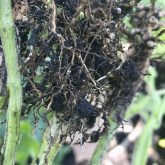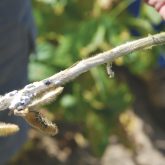How much more can be said about soybean cyst nematode that hasn’t been discussed or debated already?
- It the worst yield-robbing disease in soybeans.
- Its key resistance gene, PI 88788, has broken down both in Canada and across the U.S. Midwest.
- Once it is in your soil, there is no means of removing it, so managing SCN is the only option.
The latest figures on SCN feeding are stunning, although to a plant breeder or crop pathologist, they may only be a confirmation. According to the SCN Coalition, “nematodes are becoming ‘resistant to the resistance.’” The coalition is an organization funded by the United Soybean Board (USB) and is comprised of both private and public sector partners. According to its website, sampling results from 2018 determined the portion of samples capable of feeding on the PI 88788 source of resistance in varieties available to Ontario growers was 33 per cent.
Read Also

Sensing the soil: Root cell research finds ‘stress hormone’
Research into how root cells react to soil stressors could help plants better adapt to changes in their climate.
That may already sound high. Then, consider that the PI 88788 source is present in more than 95 per cent of soybean varieties currently available in Canada and the U.S. And then, look at the results coming out of states like Missouri, where feeding in 2018 was 100 per cent, or Michigan (94 per cent) and Tennessee (83 per cent). Illinois was also very high at 88 per cent, with many other states between 54 and 67 per cent. Only South Dakota (25 per cent) and Minnesota (17 per cent) fell below Ontario’s feeding rates.
From a yield perspective, the numbers from the SCN Coalition show soybean yields are hit by as much as 14 bushels per acre as SCN reproduction increases. That can run as much as $150 per acre.
According to Charlie Zila, plant researcher with Corteva Agriscience, the problem with SCN is obvious and well understood: The soybean sector has played out the resistance factor with 788, as it’s known. More than 20 years of relying on it as the primary source of resistance to SCN has resulted in these higher sample rates.

Zila was at the 2018 London Farm Show and made a presentation covering several different aspects of the soybean breeding sphere. Part of that presentation included details of shifting SCN resistance sources from 788 to Peking, among other sources currently in the research pipeline. Zila talked briefly about the challenges of 788’s resistance and mentioned both Peking (PI 548402) and Hartwig (PI 437654). The challenge in breeding with Peking is that it involves selecting for multiple-resistance genes, unlike PI 88788, which is controlled by one single gene. Hartwig has great potential as a multi-race source of SCN resistance but incorporating it into a breeding program is even more complex than either 788 or Peking.
“The problem with 788 is that its durability resistance has broken down and we’d like to move to other modes of action,” says Zila, who’s based near Windfall, Indiana, just north of Indianapolis. “Peking is well understood on how to breed for it and it’s something of a minor player in a lot of breeding programs. We need to work it into more of those and more populations, and ramp up breeding for that.”
When Peking was introduced into breeding programs, there were several factors impeding its use that have been overcome since then by improvements in genetic screening. Any yield drag that was found with Peking was solved while the shortage of markers 20 years ago was also corrected.
As for Hartwig and other modes of action or PI sources, Zila concedes that much of that work still lies within academia. Public universities are responsible for much of the research in understanding the genetics of new sources of resistance before they can be used in a breeding program.
“On the flip side, there’s a lot of discovery work that is already done,” Zila adds. “Some of that’s proprietary in-house work but some of it’s working with public partners. Between what we’re doing and what some of the public university partners are doing, there are definitely new sources that are early in the pipeline.”
Numbers need acknowledgement
Beyond breeding work using Peking, Hartwig and other resistance sources, much of the battle against SCN comes back to boosting awareness of the pest among growers. A survey conducted in Ontario by Syngenta in 2015 found excessively high concentrations of SCN in parts of Huron and southern Bruce counties. In some fields, more than 4,000 SCN eggs were found per 100 grams of soil, sufficient to cause yield losses of 50 per cent or more. That led to suggestions that such concentrations could only have come with SCN being present in soils for at least 10 years.
Zila states that’s 90 per cent of why the SCN Coalition was formed: to create greater awareness among growers and encourage them to get field samples done. If they have a high population count, consider getting some typing done to determine the type of resistance they’re dealing with in their fields.
“A lot of the battle against SCN is basic education and help growers be aware that they could have a problem, and realize that it’s a lot more widespread than what they thought it was,” says Zila.
The SCN Coalition has new management recommendations on its website, including:
- Test fields to know the numbers you’re dealing with.
- Rotate resistant soybean varieties. Even if it’s PI 88788, switching to a different resistant variety may slow the buildup of SCN populations.
- Rotate to non-host crops. In Ontario, those include corn, wheat, alfalfa, barley, oats and canola, along with forage grasses, sugar beets, miscanthus and switch grass.
- Consider a nematode-protectant seed treatment.
For more information go to theSCNcoalition.com.
This article originally appeared in the October 2019 issue of the Soybean Guide.
















